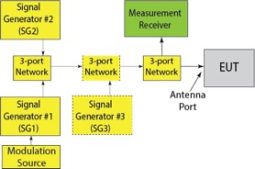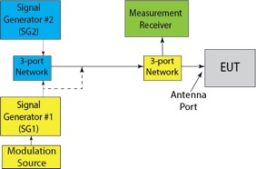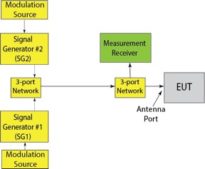Introduction
Rapid technology advances in the wireless communications world make test and evaluation of Radio Frequency (RF) devices a difficult subject. It seems that by the time a new device hits the market, it has been made obsolete by the next generation. I recall hearing from a major electronics manufacturer CEO that 90% of sales happen within 90-days of market release prompting the need for a successor. This applies to commercial products, but similar technology leaps will follow the military equipment demands from the propensity to use commercial-off-the-shelf (COTS) technology for DoD systems.
Many frequency sources are present that operate in close proximity in our daily life and within military operations including ships, vehicles, and aircraft. As the Internet of Things (IoT) expands, the military usage will expand to add more complexity to the spectrum usage and the demand for receiver operations must be included.
The three test methods we are reviewing apply to receivers to assess performance degradation from RF signals arriving at the receiver antenna port. Let’s quickly go over the three topics involved to support the test method discussions that follow.
- Intermodulation – Intermodulation results from combining several signals in a non-linear device. Harmonics of a frequency plus sum and difference frequencies, as well as multiples of the frequencies, may be created. If the amplitude of undesired frequencies is adequate for reception and the frequency is at the operating receiver frequency, interference can result in degrading the receiver performance. Many non-linear devices may be present in a receiver and non-linear junctions may be created at conductor junctions such as connectors or fractured solder joints. Rusty bolt syndrome has been used to describe certain passive intermodulation causes.
- Rejection of Undesired Signals – Tunable receivers selectively accept a desired frequency while preventing other frequencies from being detected. The ability of a receiver to reject other than the tuned frequency is a measure of receiver performance. This can support intermodulation performance rejection by attenuating signals prior to their arrival at a non-linear junction.
- Cross-Modulation – Cross modulation may appear when high-level amplitude modulated signals cause an over-drive condition in a receiver creating non-linear operation resulting in a transfer of the undesired signal modulation to the intentionally received signal. This condition may exist when the strong carrier is within the same band as the desired tuned frequency.
MIL-STD-461G, the current revision, lists these tests with limited applicability with the limitation to RF receiver susceptibility. With the release of MIL-STD-461D and MIL-STD-462D and remaining today the standard defers to the procurement specification for limits and methods with only general testing techniques being provided. This approach is taken because today’s technology provides a vast array of wireless communications and the basic techniques from the early days of MIL-STD-461 may not reveal risks.
The testing evaluates the receiver, not external causes that produce an input causing susceptibility, so the test configuration needs close attention to prevent false indications. Connector adapters, poorly bonded junctions and contamination can create passive intermodulation; signal source harmonics can provide an in-band signal appearing as a lack of rejection, so pay close attention to the setup minimizing excessive components and connections.
As we review the testing approach, please note that the specific testing defined in the procurement specification will take precedence – this review is to provide an understanding of the goals and will require that a detailed test procedure be developed for a specific device receiver. The test procedure should clearly define what constitutes susceptibility in a quantifiable manner.
To support the discussion, let’s establish a few receiver parameters to use for the test method discussions in this review. Our hypothetical Equipment Under Test (EUT) is a UHF radio with selectable AM and FM capability operating in the 225 – 400 MHz frequency range with a 25 kHz channel size. The radio sensitivity is 10 µV. The intermediate frequency (IF) is 10.7 MHz. The rejection requirement is 66 dB within the tuning range and 80 dB outside the tuning range.
CS103 – Intermodulation
Figure 1 shows a basic CS103 test configuration where two signals are routed to the EUT receiver input. The dashed line signal generator (SG3) and associated 3-port network are present only if the receiver needs to have an intentional receive signal to function. Depending on the signal generator performance, filtering may be needed between the generator and 3-port networks. The SG1 in our diagram must support modulation used by the EUT to allow the susceptibility to be identified if susceptibility is present.

Figure 1: CS103 Test Configuration
The 3-port network is normally a hybrid combiner/splitter and should not be confused with a mixer. The 3-port network configured as a combiner provides 2-input ports and 1-output port where both input signals appear simultaneously. The 3-port network configured as a splitter support 2-output ports with one input port. The splitter configuration is used with SG3 if required and the measurement receiver. Based on the EUT parameters provided, a Mini-Circuits ZAPD-2-252 and a Mini-Circuits ZN2PD-63S giving good isolation between input ports, reasonably low insertion loss and the necessary frequency range coverage are selected as our 3-port networks. The two 3-port networks have some overlap in the frequency coverage allowing the test frequency range to be supported. The EUT does not require a SG3 so two of each selected 3-port networks are needed. Note that I am not sponsored by or promoting Mini-Circuits – they just happened to pop-up in a search among many suppliers of RF products. When selecting your 3-port network, examine the specification sheet to confirm it will meet your requirements.
The measurement receiver can be an EMI receiver or spectrum analyzer with the ability to measure both input signals simultaneously. It is feasible to use two measurement receivers with a splitter to support measurement of the two input signals independently if more resolution is needed.
Now that we have selected the test equipment let’s go through the process.
- Configure the test setup with the higher frequency 3-port networks installed. If the lower frequency 3-port network is rated to include the upper test frequency, then use the lower frequency networks.
- Select the first EUT test frequency and tune the EUT to this frequency. Set SG1 to the EUT test frequency with the RF amplitude at a very low level and apply modulation. SG2 RF output remains off.
- Adjust the SG1 amplitude to produce the EUT standard reference output (SRO) (SRO is the correct operation of the EUT such as the ability to hear an audio modulation or process data from the modulation). The SG1 output is now set to the lowest amplitude that produces the SRO. Record the SG1 output amplitude and the signal amplitude measured by the measurement receiver. Note that the path losses will require that the signal generator amplitude be higher than the EUT specified sensitivity.
- Turn SG1 RF off. Apply the modulation to SG2 and enable the RF output. Adjust the SG2 frequency to the EUT test frequency and the amplitude to produce the EUT SRO and record the SG2 output amplitude and the signal amplitude measured by the measurement receiver at lowest amplitude that produces the SRO.
- If the EUT requires that SG3 be necessary to establish operation of the EUT then set the frequency and amplitude to produce the SRO after turning off the SG2 RF output. Increase the amplitude by 3 dB. This will produce stable operation with a low-level reception being simulated and allow intermodulation to interfere with normal operation if the device is susceptible. This setting will remain throughout the testing.
- Remove modulation from SG2 and apply modulation to SG1. Turn on the RF output of both signal generators. Adjust the SG1 to the in-band test amplitude (SRO + limit) then increase the frequency until the SRO is lost. If the frequency is out-of-band, increase the SG1 amplitude to the out-of-band limit and increase the frequency until SRO is lost. Record the frequency of SG1 as f1. The difference between f1 and the EUT tuned frequency is Δf.
- Set SG2 frequency to f1 + Δf and increase the amplitude to the in-band or out-of-band test amplitude (SRO + limit) depending on the frequency. Scan by increasing the SG2 frequency until the upper range test end frequency is reached while monitoring the EUT for indications of susceptibility. Observe that the scan rate or frequency step size of the SG2 frequency sweep conform to the greater of the minimum per MIL-STD-461 or the EUT cycle time to ensure susceptibility indications can be detected.
- If susceptibility is detected determine if intermodulation is the cause by reducing the SG1 amplitude to zero. If the susceptibility remains, it is not an intermodulation product and can be ignored for this test.
- If susceptibility is a result of intermodulation, decrease the amplitude of both SG1 and SG2 equally until the EUT is no longer susceptible. Record the frequency and amplitude at the measurement receiver of SG1 and SG2. Determine the intermodulation rejection by subtracting the SG1 amplitude from the SRO + limit amplitude.
- Configure the setup to the lower frequency range by changing the 3-port network if necessary. If the test configuration hardware changed to test the lower frequency range:
- Set SG1 to the EUT test frequency with the RF amplitude at a very low level and apply modulation. SG2 RF output remains off.
- Adjust the SG1 amplitude to produce the EUT standard reference output (SRO) (SRO is the correct operation of the EUT. The SG1 output is now set to the lowest amplitude that produces the SRO. Record the SG1 output amplitude and the signal amplitude measured by the measurement receiver.
- Turn SG1 RF off. Apply the modulation to SG2 and enable the RF output. Adjust the SG2 frequency to the EUT test frequency and the amplitude to produce the EUT SRO and record the SG2 output amplitude and the signal amplitude measured by the measurement receiver at the lowest amplitude that produces the SRO.
- If the EUT requires that SG3 be necessary to establish operation of the EUT then set the frequency and amplitude to produce the SRO after turning off the SG2 RF output. Increase the amplitude by 3 dB. This setting will remain throughout the testing.
- Set SG1 frequency to the EUT operating frequency – Δf and increase the amplitude to the in-band or out-of-band test level depending on the frequency. Verify that SRO is lost. Record the frequency as f2.
- If SRO is not lost, decrease the frequency until SRO is lost.
- Set SG2 frequency to f2-Δf and adjust the amplitude to the in-band or out-of-band test limit depending on the frequency. Scan by decreasing the SG2 frequency until the lower range test end frequency is reached while monitoring the EUT for indications of susceptibility. Observe that the scan rate or frequency step size of the SG2 frequency sweep conform to the greater of the minimum per MIL-STD-461 or the EUT cycle time to ensure susceptibility indications can be detected.
- Repeat for the next selected test frequency or mode of operation.
Note that measurements at the measurement receiver should be used for setting levels to compensate for variations in the configuration from path losses.
CS104 – Rejection of Undesired Signals
The goal is to determine the amount of rejection to signals received outside of the tuned frequency that can produce spurious responses.
Figure 2 shows a basic CS104 test configuration where two signals are routed to the EUT receiver input. SG2 and the associated 3-port network may not be required if the EUT responds to a single signal (e.g., AM or FM receiver). The 3-port networks are similar to those discussed above but the test frequency range may require different models. Depending on the signal generator performance, filtering may be needed between the generator and 3-port networks to reduce the effects of harmonic outputs. The SG1 in our diagram must support modulation used by the EUT to allow the susceptibility to be identified if susceptibility is present.

Figure 2: CS104 Test Configuration
In our example EUT, a single generator test configuration may be used but I will describe both a single and dual signal generator approach.
The single generator process is:
- Configure the test setup as shown without SG2 and associated 3-port network using the high frequency 3-port networks.
- Set SG1 to the EUT tuned frequency, apply modulation and increase the amplitude until SRO is attained. Record SG1 frequency and amplitude.
- Increase the test level by the in-band limit then increase the frequency until SRO is lost. If the frequency is out-of-band, increase the amplitude to the out-of-band limit and increase the frequency until SRO is lost. Record the frequency and amplitude of the signal.
- Scan by increasing the SG1 frequency until the upper range test end frequency is reached while monitoring the EUT for spurious responses. Observe that the scan rate or frequency step size of the SG2 frequency sweep conform to the greater of the minimum per MIL-STD-461 or the EUT cycle time to ensure susceptibility indications can be detected.
- If susceptibility is detected, lower the SG1 amplitude until SRO is restored and record the amplitude of the signal. Record the frequency and amplitude at the measurement receiver of SG1. Determine the rejection by subtracting the SG1 amplitude from the SRO + limit amplitude.
- Configure the setup with the low-frequency range 3-port networks. If the hardware required change then:
- Set SG1 to the EUT tuned frequency, apply modulation and increase the amplitude until SRO is attained. Record SG1 frequency and amplitude.
- Set the SG1 frequency to the tuned frequency of the EUT and the amplitude to SRO + limit. Decrease the test level by the in-band limit then decrease the frequency until SRO is lost. If the frequency is out-of-band, increase the amplitude to the out-of-band limit and decrease the frequency until SRO is lost. Record the frequency and amplitude of the signal.
- Scan by decreasing the SG1 frequency until the lower range test end frequency is reached while monitoring the EUT for spurious responses. Observe that the scan rate or frequency step size of the SG2 frequency sweep conform to the greater of the minimum per MIL-STD-461 or the EUT cycle time to ensure susceptibility indications can be detected.
- Repeat for the next selected test frequency or mode of operation.
The dual signal generator process is:
- Configure the test setup as shown with SG2 and associated 3-port network using the high frequency 3-port networks.
- Set SG1 to the EUT tuned frequency, apply modulation and increase the amplitude until SRO is attained. Record SG1 frequency and amplitude.
- Turn SG1 RF off. Apply the modulation to SG2 and enable the RF output. Adjust the SG2 frequency to the EUT test frequency and the amplitude to produce the EUT SRO and record the SG2 output amplitude and the signal amplitude measured by the measurement receiver at the lowest amplitude that produces the SRO.
- Remove modulation from SG2. Set SG1 to the EUT tuned frequency, apply modulation and increase the amplitude until SRO is attained.
- Set SG2 to the tuned frequency without modulation and increase the amplitude to the test level (SRO + test limit). Scan by increasing the SG2 frequency until the upper range test end frequency is reached while monitoring the EUT for indications of susceptibility. Observe that the scan rate or frequency step size of the SG2 frequency sweep conform to the greater of the minimum per MIL-STD-461 or the EUT cycle time to ensure susceptibility indications can be detected.
- If a spurious response is observed verify that it is not an intermodulation product.
- If susceptibility is detected, lower the SG2 amplitude until the spurious response is not present and record the amplitude of the signal. Record the frequency and amplitude at the measurement receiver. Determine the rejection by subtracting the SG2 amplitude from the SRO + limit amplitude.
- Configure the setup with the low-frequency range 3-port networks. If the hardware required change then:
- Set SG1 to the EUT tuned frequency, apply modulation and increase the amplitude until SRO is attained. Record SG1 frequency and amplitude.
- Turn SG1 RF off. Apply the modulation to SG2 and enable the RF output. Adjust the SG2 frequency to the EUT test frequency and the amplitude to produce the EUT SRO and record the SG2 output amplitude and the signal amplitude measured by the measurement receiver at the lowest amplitude that produces the SRO.
- Set SG2 to the tuned frequency without modulation and increase the amplitude to the test level (SRO + test limit). Scan by decreasing the SG2 frequency until the lower range test end frequency is reached while monitoring the EUT for indications of susceptibility.
- Repeat for the next selected test frequency or mode of operation.
CS105 – Cross Modulation
The goal is to determine the amount of rejection to modulation transfer for signals received outside of the tuned frequency that can produce receiver amplitude responses. This test is applicable to receivers that use amplitude modulation.
Figure 3 shows a basic CS105 test configuration where two signals are routed to the EUT receiver input. The 3-port networks are like those discussed above but the test frequency range may require different models. Depending on the signal generator performance, filtering may be needed between the generator and 3-port network to reduce the effects of harmonic outputs. SG1 and SG2 in our diagram must support modulation used by the EUT to allow the susceptibility to be identified if susceptibility is present.

Figure 3: CS105 Test Configuration
The test frequency range is the EUT tuned frequency ±IF, so we will use the low frequency 3-port networks for our example. The process is:
- Configure the test setup as shown with SG2 and associated 3-port network using the low frequency 3-port networks.
- Set SG1 to the EUT tuned frequency, apply modulation and increase the amplitude until SRO is attained. Record SG1 frequency and amplitude.
- Turn SG1 RF off. Apply the modulation to SG2 and enable the RF output. Adjust the SG2 frequency to the EUT test frequency and the amplitude to produce the EUT SRO and record the SG2 output amplitude and the signal amplitude measured by the measurement receiver at lowest amplitude that produces the SRO.
- Set SG1 to the EUT tuned frequency, apply EUT specified modulation and increase the amplitude to SRO + 10 dB.
- Set SG2 to the EUT tuned frequency, apply the test specification modulation (AM receiver = 30% AM 400 Hz sine wave; FM receiver – unmodulated; Pulsed receiver = 80% of spectral energy with 3 dB bandwidth of the receiver) and increase the amplitude to the SRO + limit level.
- Scan SG2 above and below the EUT tuned frequency to the upper and lower end frequencies while monitoring the EUT performance.
- If susceptibility is observed, confirm that the cause is cross-modulation by removing the SG1 modulation. If the susceptibility disappears, the cause is cross-modulation.
- If susceptibility is observed, lower the SG2 amplitude until the susceptibility is not present and record the amplitude of the signal. Record the frequency and amplitude at the measurement receiver. Determine the rejection by subtracting the SG2 amplitude from the SRO + limit amplitude.
- Repeat for the next selected test frequency or mode of operation.
Summary
As mentioned earlier, planning for this test is essential and that planning includes defining the hardware necessary to cover the test frequency range.
Don’t forget that the test configuration can influence the test, so make sure that you minimize the hardware and associated connectors/adapters. Look for signal generator harmonic outputs that can present a false indication of susceptibility.
Most specifications will have an upper signal generator amplitude limited to 10 dBm. If not specified this should be determined because the receiver will easily be driven into the non-linear operating region when exposed to very high-level signals.
The appendix of MIL-STD-461G provides a lot of information regarding the specification and rationale for determining the test levels.
I have an Excel spreadsheet that follows this procedure outline that you can use as an example. I can provide a copy of this spreadsheet at no charge if you request. Send an email to me stevef@compliancedirection.com with CS103_104_105 Example Spreadsheet in the subject line, provide your contact information, and state that you agree to NOT place the spreadsheet in the public domain.






